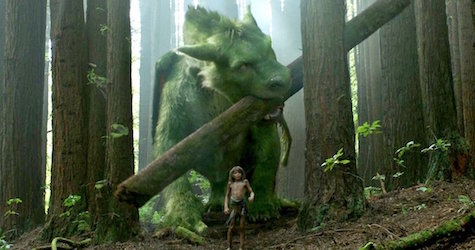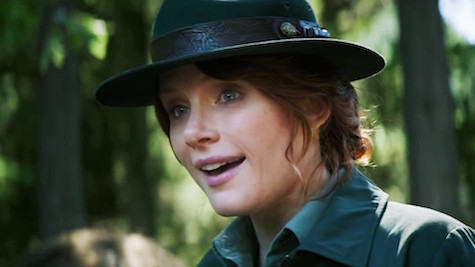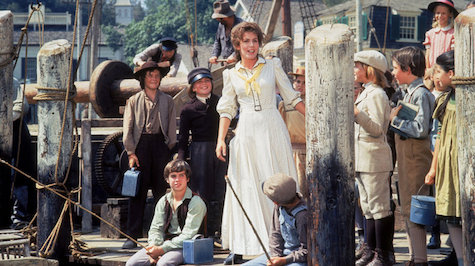In the original Pete’s Dragon, a charlatan named Doc Terminus turns up in a town called Passamaquoddy. He’s been there before, barely remembers it, definitely doesn’t like it, and can’t even spell its name.
We might say the same about David Lowery and his recollection of the 1977 classic whose title he’s borrowing here in 2016. But whereas Terminus tries to chop his dragon up, Lowery only wants to put him on a diet.

In the new Pete’s Dragon, tragedy leaves young Pete (Oakes Fegley) stranded in the woods. He’s rescued by a sometimes-invisible dragon, which he calls Elliot. They spend six years together in the forest, but then a kindly ranger named Grace (Bryce Dallas Howard) starts asking questions.
Like most people in their town, Grace grew up hearing tall tales about a dragon from her dad (Robert Redford) but never believed them. Now this strange boy is running around with a lot of the same dragon talk, though, so she’s doubting her doubts anew.
Lowery seems to think the original Dragon is bloated, bogged down with music, and too demanding for a modern audience. He aims to strip it to its essence, and sure enough, his version of the story spends its entirety within that emotional core. The movie works there. Pete’s bond with Elliot is deeply moving. The familial love they share is unconditional, defiant, and angry when challenged. You’ll feel a swell of that same love while watching them. It’s a beautiful thing.
But the rest of the characters might as well be lost at sea. Grace is sweetly bland, a mother figure only because the story tells us she is, not because she really invests herself in Pete. She’s a forest ranger married to a lumberjack captain (Wes Bentley), a relationship only a studio exec would swipe right on.
A different lumberjack, Gavin (Karl Urban), stands in for Doc Terminus. Literally his only job in the movie is to scream, “DRAGON!” in each of his half-dozen scenes. A Charlie Chaplin script would have been harder to memorize.
Meanwhile, Robert Redford looks the part of a kooky old fabulist, but his delivery is right off a cue card. For that matter, the entire adult cast seems intensely aware they’re making a “kids’ movie.”

Lowery’s greatest accomplishment here is highlighting just how complex and effective the first Dragon is. At over two hours, it boasts an enormous cast of characters. You could scatter them on a map, draw a line between any two, and really ruminate on the relationship between them. It is a story about the best and worst of humanity, explored with sophistication and an earnest interest in the idea of faith.
Nora (Helen Reddy) can’t bring herself to believe in Elliott, and the movie interrogates her skepticism. Her ultimate face-to-face with the dragon is a touchstone moment with enormous emotional payoff, all of it mirroring her parallel struggle to believe her long-lost boyfriend might someday resurface.
Compare that to Grace’s turn of faith here, which happens on a dime and can be summed up with a simple, “Oh, so he is real. Huh!” It’s not so much a moment as a shrug.
Of course, the original is a big, Broadway-style musical. Songs are prominent in Lowery’s version, too, but less Mickey Rooney and more Mumford & Sons. The director’s decision to repeatedly have characters sing or play a song — even about a dragon — while never once hinting at the originals seems almost disdainful of the legacy he’s trading on.
(Note: A disposable cover of the Oscar-nominated “Candle on the Water” does appear on the soundtrack, but you won’t find it in the movie — not even in the end credits.)

But even skinned and filleted, Pete’s Dragon has incredible heart. This may be a reduction of the original grandeur, but there’s still enough warmth and charm to get swept up in.
I saw it in a huge theater, nearly every seat filled, and the applause were tremendous — not only at the end but even during intervening scenes of triumph. That’s impressive. And for a lifelong Pete’s Dragon fanatic like myself, it’s gratifying.
For thirty years, I’ve been singing the original’s praises, only to find most people have a hazy memory of it at best. Until now, the Walt Disney Company has done relatively little to change that.
The last few months, then, have been sort of surreal. Suddenly, the words “Pete’s Dragon” are everywhere I look, but they’re attached to something that doesn’t quite look like the thing I love. But as tends to be the case with Disney movies these days, the experience waiting inside the theater isn’t nearly as eye-rolling as the TV commercials suggest.
In the original story, Elliott stays with one child for as long as he’s needed, and then it’s off to another. In 1977, he found his first generation. Now he’s come back for a new one. It’s too bad their hunger-panged Elliot doesn’t have as much to offer, but maybe he’ll entice them to discover “Elliott with the two Ts” next.
As Nora told us in ’77, “There’s room for everyone in this world.” I suppose that goes for remakes too. If Disney’s decent-enough retelling extends a legacy that might not otherwise have lasted, I’m happy to make some space for it.